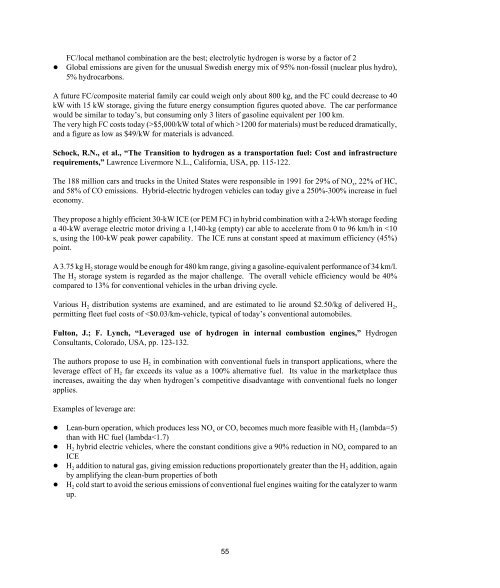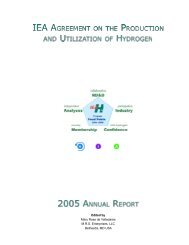Technology Status of Hydrogen Road Vehicles
Technology Status of Hydrogen Road Vehicles
Technology Status of Hydrogen Road Vehicles
You also want an ePaper? Increase the reach of your titles
YUMPU automatically turns print PDFs into web optimized ePapers that Google loves.
FC/local methanol combination are the best; electrolytic hydrogen is worse by a factor <strong>of</strong> 2<br />
! Global emissions are given for the unusual Swedish energy mix <strong>of</strong> 95% non-fossil (nuclear plus hydro),<br />
5% hydrocarbons.<br />
A future FC/composite material family car could weigh only about 800 kg, and the FC could decrease to 40<br />
kW with 15 kW storage, giving the future energy consumption figures quoted above. The car performance<br />
would be similar to today’s, but consuming only 3 liters <strong>of</strong> gasoline equivalent per 100 km.<br />
The very high FC costs today (>$5,000/kW total <strong>of</strong> which >1200 for materials) must be reduced dramatically,<br />
and a figure as low as $49/kW for materials is advanced.<br />
Schock, R.N., et al., “The Transition to hydrogen as a transportation fuel: Cost and infrastructure<br />
requirements,” Lawrence Livermore N.L., California, USA, pp. 115-122.<br />
The 188 million cars and trucks in the United States were responsible in 1991 for 29% <strong>of</strong> NO x, 22% <strong>of</strong> HC,<br />
and 58% <strong>of</strong> CO emissions. Hybrid-electric hydrogen vehicles can today give a 250%-300% increase in fuel<br />
economy.<br />
They propose a highly efficient 30-kW ICE (or PEM FC) in hybrid combination with a 2-kWh storage feeding<br />
a 40-kW average electric motor driving a 1,140-kg (empty) car able to accelerate from 0 to 96 km/h in













